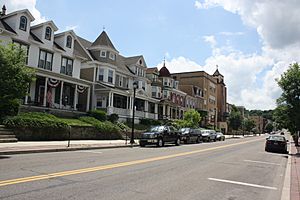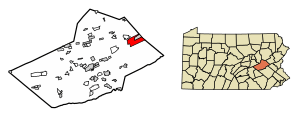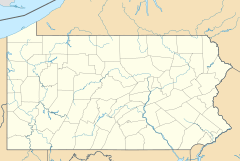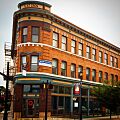Tamaqua, Pennsylvania facts for kids
Quick facts for kids
Tamaqua
tëmakwe
|
|
|---|---|
|
Borough
|
|

West Broad Street in Tamaqua in July 2013
|
|
| Etymology: Corruption of Native American word "Tankamochkhanna" meaning "Little Beaver Stream" | |

Location of Tamaqua in Schuylkill County, Pennsylvania (left) and of Schuylkill County in Pennsylvania (right)
|
|
| Country | |
| State | |
| County | Schuylkill |
| Incorporated | 1832 |
| Area | |
| • Total | 9.72 sq mi (25.17 km2) |
| • Land | 9.56 sq mi (24.77 km2) |
| • Water | 0.16 sq mi (0.40 km2) |
| Elevation | 870 ft (270 m) |
| Population
(2020)
|
|
| • Total | 6,934 |
| • Estimate
(2021)
|
6,932 |
| • Density | 696.93/sq mi (269.07/km2) |
| Demonym(s) | Tamaquan |
| Time zone | UTC-5 (EST) |
| • Summer (DST) | UTC-4 (EDT) |
| ZIP Code |
18252
|
| Area code(s) | 570 and 272 |
| FIPS code | 42-76032 |
| School district | Tamaqua Area |

Tamaqua (pronounced tuh-MAH-kwuh) is a small town, called a borough, in eastern Schuylkill County, Pennsylvania. It's located in an area known as the Coal Region of the United States. In 2020, about 6,934 people lived there.
Tamaqua was created from parts of West Penn and Schuylkill Township. It is part of the larger Pottsville area. The town is about 38 miles (61 km) northwest of Allentown and 87 miles (140 km) northwest of Philadelphia.
Contents
History of Tamaqua
Early Settlement and Growth
Tamaqua was first settled in 1799 by Burkhardt Moser, his son Jacob, and John Kershner. They built homes and a sawmill where the Little Schuylkill River and Panther Creek meet. This area is now downtown Tamaqua.
The town was almost named Tuscarora, but another town already had that name. So, they chose Tamaqua, which comes from a Native American word meaning "running water." This name fit well because the Tamaqua Creek (now called Wabash) flows through the area.
For the first 20 years, farming and making lumber were the main jobs in Tamaqua. But then, in 1817, a very important discovery was made: anthracite coal. This special type of coal was found by Berkhard Moser and his son Jacob. At first, only a small amount of coal was mined and sold, mostly to blacksmiths. But by 1832, coal mining really took off, with 14,000 tons being sold.
Tamaqua officially became a borough in 1832. The first coal processing plant, called "The Greenwood," was built where the first mine was located.
Immigrants and Challenges
Many immigrants came to Tamaqua looking for work in the coal mines. In the 1840s and 1850s, people from Ireland, Wales, and Germany arrived. Later, in the late 1800s and early 1900s, many more came from Italy, Lithuania, Russia, Ukraine, Slovakia, and Poland.
During the 1860s and 1870s, Tamaqua was a central spot for a group called the Molly Maguires. This group was involved in labor disputes during that time.
The Railroad Station
The Tamaqua Railroad station was built in 1874. For many years, it was a busy place for trains. However, in the mid-1980s, passenger train service stopped, and the station became empty. People wanted to tear it down, but a group called Save Our Station (S.O.S.) worked hard to raise money. They saved the station and had it beautifully restored. It reopened in 2004 and now has a restaurant and gift shop. Special train rides sometimes leave from the station during the annual Heritage Festival.
20th Century Changes
Tamaqua continued to be a busy coal town in the early 1900s. But by the 1950s, coal mining started to slow down, and the town's population began to shrink.
In 1955, a big storm called Hurricane Diane badly damaged Tamaqua's railroad yards, and they never fully recovered. In 1971, Tamaqua grew bigger by adding Rahn Township, which included Owl Creek, home to the world's first fish hatchery.
A local company, Morgan Knitting Mills, started in 1945. It became a major employer in the area. The company's founder, John E. Morgan, and his wife, Anna Hoban Morgan, even invented the well-known thermal underwear.
Several important buildings in Tamaqua, like the Anthracite Bank Building and the Tamaqua station, have been added to the National Register of Historic Places. This means they are recognized as important historical sites.
Modern Times
In 2007, Tamaqua made news by passing a special law. This law gives ecosystems (like forests and rivers) legal rights. It means that the town government or any resident can file a lawsuit to protect the local environment. Other towns have followed Tamaqua's lead and passed similar laws.
Geography of Tamaqua
Tamaqua is located in a valley in the southern part of Pennsylvania's Coal Region. It's nestled in the Appalachian Mountains and is part of the Schuylkill River area. The town sits at the western edge of the Pocono Mountains.
The borough covers about 10 square miles (25.9 square kilometers). Most of this is land, with a small amount of water. Three streams flow through Tamaqua: the Little Schuylkill River, Panther Creek, and Wabash Creek.
Tamaqua's average height above sea level is about 870 feet (265 meters). The climate here has warm summers.
Getting Around Tamaqua
Roads and Highways
The main road in Tamaqua is Pennsylvania Route 309. This highway connects Tamaqua to bigger cities like Allentown and Philadelphia to the south, and Hazleton and Wilkes-Barre to the north. Another important road is U.S. Route 209, which runs through the borough and connects Tamaqua to nearby towns like Pottsville and Jim Thorpe.
Other highways near Tamaqua include Pennsylvania Route 54, Pennsylvania Route 443, Pennsylvania Route 895, and Pennsylvania Route 902. These roads help connect the Tamaqua area to the Pocono Mountains, the Lehigh Valley, and other parts of Pennsylvania. Major interstate highways like I-81, I-80, I-476, and I-78 are also close by.
Railroads
Tamaqua was once a busy center for two major railroads: the Reading Railroad and the Lehigh and New England Railroad. There used to be a large rail yard with many tracks passing through town. However, as the coal industry declined, the railroads became less active.
Today, only a single track runs through town, operated by the Reading Blue Mountain and Northern Railroad. Tamaqua still has a small rail yard and is an important connection point for tracks going in different directions.
People of Tamaqua
As of the 2020 census, Tamaqua had a population of 6,934 people. The town is home to a diverse community.
Media and Communication
Tamaqua has its own FM radio station, WMGH, known as Magic 105.5. The town also receives television signals from nearby cities like Scranton and Wilkes-Barre. Depending on the cable provider, people in Tamaqua might also get TV channels from Philadelphia and New York City.
Churches
Tamaqua is home to several churches, including:
- Bethany E.C Church
- Calvary Episcopal Church
- First United Methodist Church
- New Life Assembly of God
- St. John XXIII
- St. John's Evangelical Lutheran
- St. John's United Church of Christ
- Trinity United Church of Christ
- Zion Evangelical Lutheran
Education in Tamaqua
Local Schools
Students in Tamaqua attend schools that are part of the Tamaqua Area School District. This district includes several schools:
- Tamaqua Area Senior High School (Grades 9–12)
- Tamaqua Area Middle School (Grades 6–8)
- Tamaqua Area Elementary School (Grades K–5)
- Rush Elementary School (Grades K-2)
- St. Jerome Regional School (Grades PreK – 8)
- West Penn Elementary School (Grades K-5)
- Marian Catholic High School (Grades 9–12)
College Opportunities
Tamaqua also has a branch of the Lehigh Carbon Community College (LCCC), called the Morgan Center. This college offers classes for students who want to continue their education after high school.
Events
Tamaqua hosts an event called Playa del Fuego twice a year. This event is inspired by the Burning Man festival. The spring event happens during Memorial Day weekend, and the fall event takes place during Columbus Day weekend.
Notable People from Tamaqua
Many interesting people have come from Tamaqua, including:
- Henry Aurand (1894–1980), a former Lt. General in the United States Army.
- Charles Justin Bailey (1859–1946), a Major-General who led the 81st Infantry Division in World War I.
- Henry L. Cake (1827–1899), a commander in the Civil War and a U.S. Congressman.
- Jacob Kulick (born 1992), a recording artist, singer, and songwriter.
- Sean Love (born 1968), a former professional football player.
- G. Raymond Nye (1889–1965), an American actor from the silent movie era.
Images for kids
See also
 In Spanish: Tamaqua para niños
In Spanish: Tamaqua para niños










